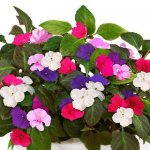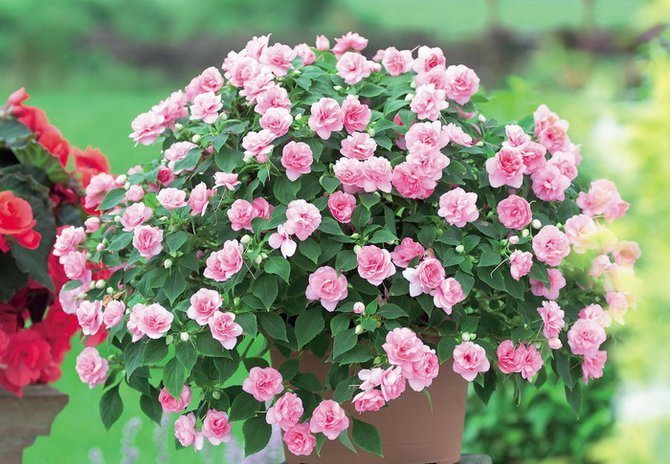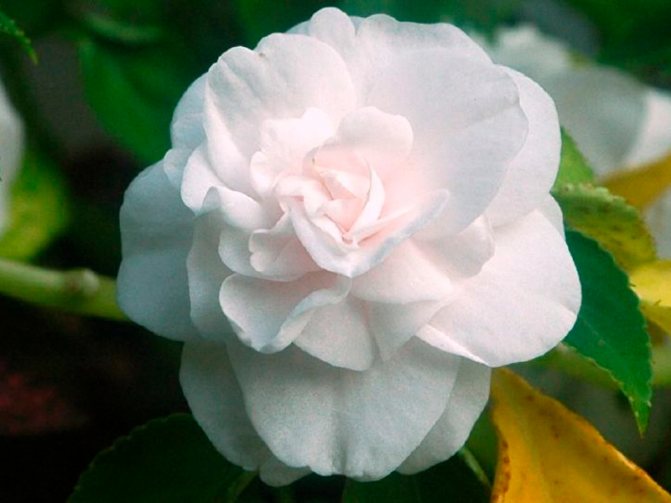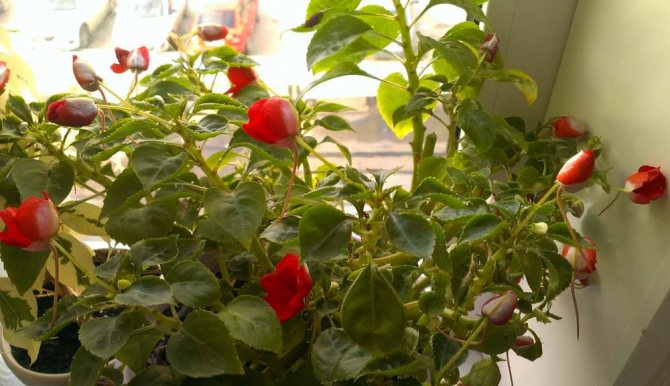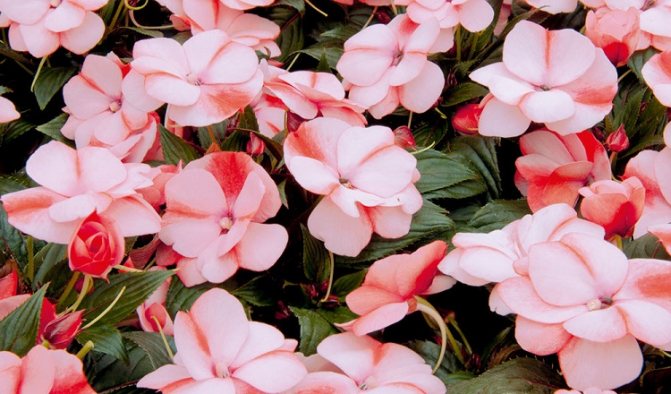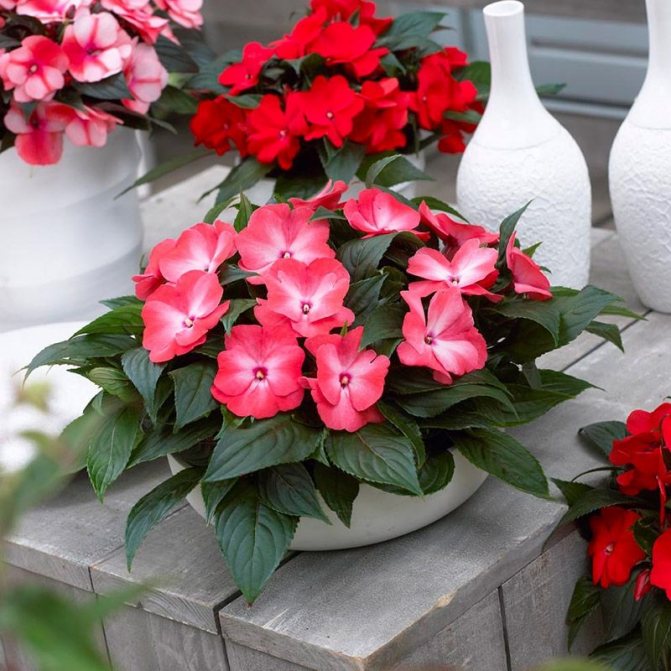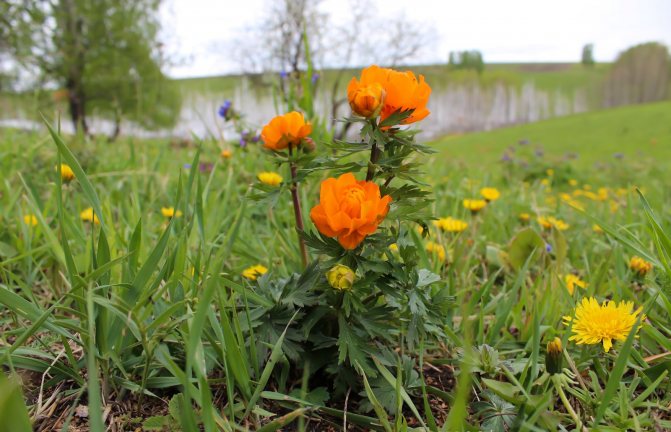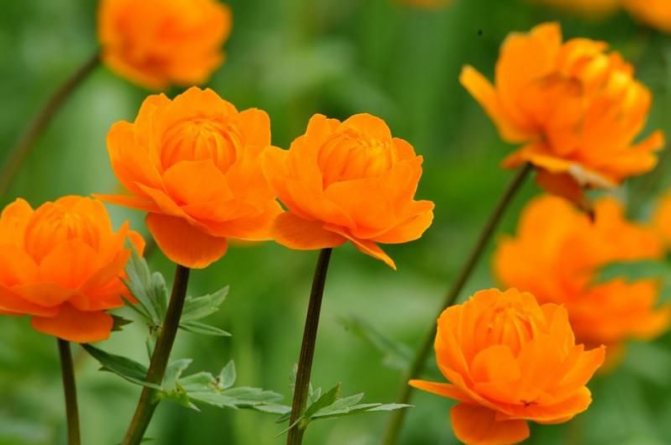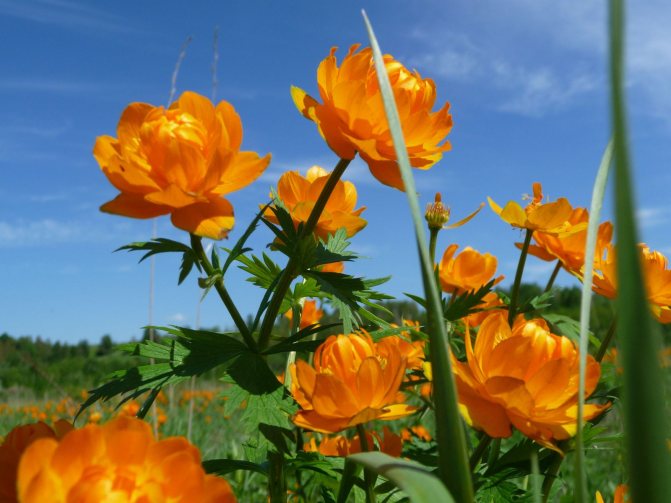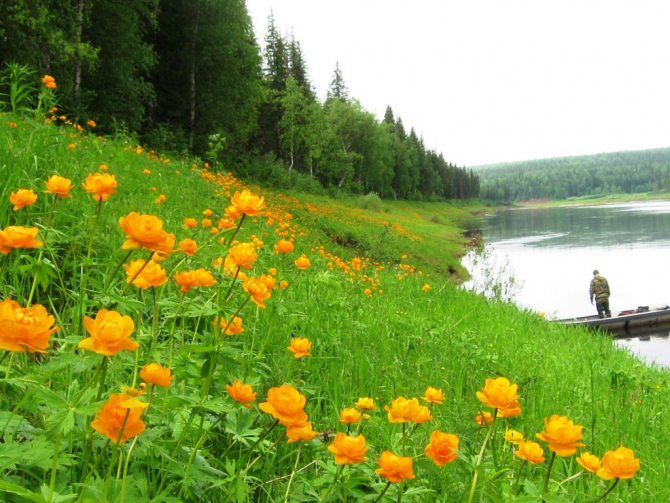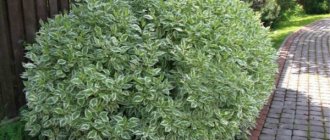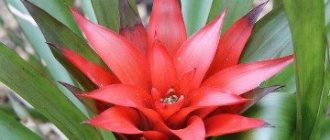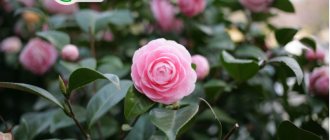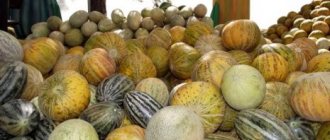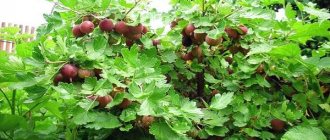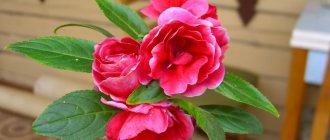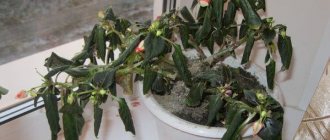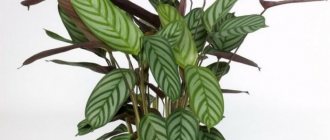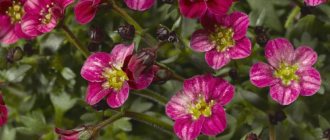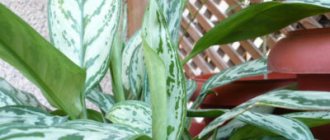Touch-me-not, ever-flowering, light, Vanka wet flower - all these are the names of one plant, which is often found in our apartments. The homeland of this lovely flower is tropical Asia and Africa. It is one of the most unpretentious and easy to grow at home plants.
The twig takes root easily, grows quickly and looks very impressive during flowering: its compact bushes, strewn with bright flowers, can decorate any room. The flower Vanka wet has another name - balsam. With good care, it can bloom almost all year round, and providing it with favorable conditions is not a big deal.

Even a novice florist can easily cope with the cultivation of this plant. It is perennial, but due to its rapid growth, usually the shoots are elongated, the bush becomes sprawling and rather quickly loses its compact shape. Therefore, balsam lovers often in the spring carry out cuttings of old plants, growing new bushes.
Balsam blooms best when planted in a slightly cramped pot or container. A plant in a pot that is too spacious will not bloom well.
Description of the plant and its varieties


The balsam genus includes about four hundred plant species. Indoor floriculture mainly grows:
- balsam Holst;
- sultan balsam;
- Waller's balsam;
- New Guinea hybrids.
The flowers of the wet vanka are distinguished by a huge variety of shades: from white and pale pink to red and maroon. Plants with bicolor petals are becoming more common. Recently, breeders have bred varieties with flowers that are much larger in size than the usual indoor balsams. At the same time, the bushes of such plants are still compact.
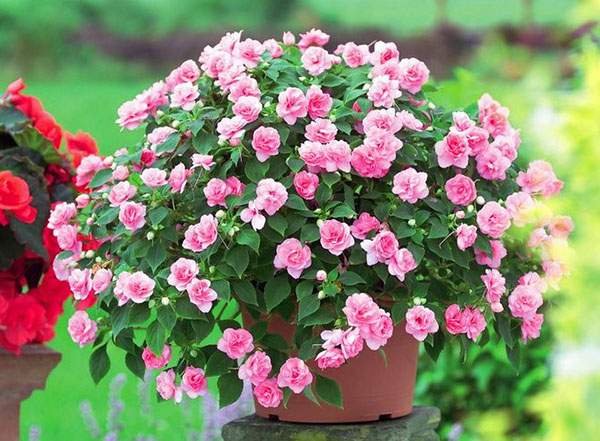

Given the popularity of balsam for indoor cultivation, breeders continue to work on creating new varieties. The hybrids that have appeared recently are striking not only by the size of the flowers, but also by their color and shape. Varieties with double flowers have already become quite common, which look great in landscaping rooms and balconies.
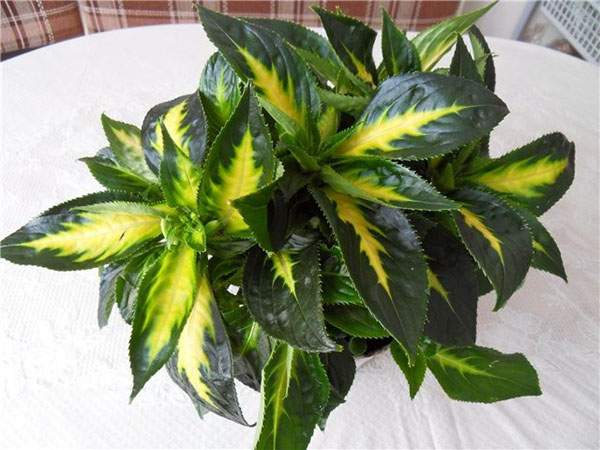

Balsam bushes, densely covered with bright flowers, are very decorative. However, this was not enough for the breeders, and varieties with beautiful variegated leaves appeared. Such plants look very attractive even at a time when the flower buds have not yet blossomed. This can be seen in the photo of a wet vanka with variegated leaves.
Variegated varieties need to create the same conditions as usual. They require the same care, with only one difference: in winter, the temperature of their content should be higher than for plants with solid green leaves.
Name
Light flower (Impatiens), aka balsam, a representative of the balsam family. A delicate and beautiful flower appeared earlier than others in home floriculture.
The first balsam in Europe was seen by the English queen Elizabeth I, who received it as a gift. She was struck by an unusual flower with frozen sugar tears. For its lush bloom, Europeans call the flower "Lizzy Lazy", "Beautiful Wreath" or "Zealous Lisa".
In the 19th century, the light was brought to Russia.Here he was appreciated for his unpretentiousness and was called an eternal flower, Vanka is wet or touchy Against the background of dark foliage, the flowers of the plant burn like lights, so they called him a light. And "Vanka wet" is called for the property of emitting water droplets on leaves in bad weather and foggy weather, when a thunderstorm approaches, from abundant watering. Thus, the plant gets rid of excess moisture. The droplets dry out and turn into crystals.
There is one more feature of the plant. Juicy, green fruits of balsam dry quickly and turn into a box. When touched, it bursts, shooting large seeds at a distance of up to 2 meters. After that, it immediately closes its doors inward. So it turns out that "touchy".


Appearance
Caring for balsam at home
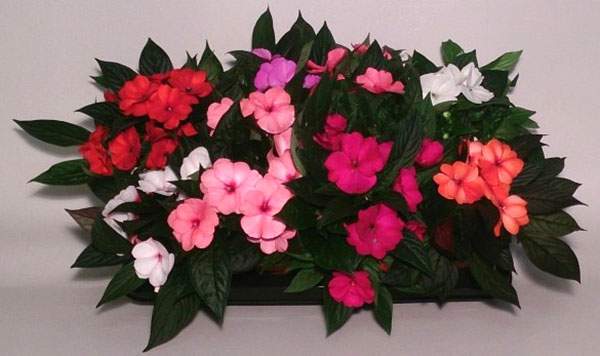

In order for the plant to thank you with lush and bright flowering with the onset of summer, it is important to know how to properly care for this flower. Vanka wet is an unpretentious plant, for its growth and flowering conditions are needed that are not at all difficult to create at home:
- Temperature: The optimum temperature for balsam is about 18 degrees. In winter, you need to make sure that it does not drop below 13 degrees. In summer, the temperature should not rise above 22 degrees. Too hot and dry conditions can cause leaves to curl and fall off.
- Lighting: good, but diffused. The plant needs to be shaded from bright sunlight. Avoid placing the balsam pot or container on the sill of the south window. The plant can tolerate some shade, but in this case it will not bloom.
- Watering: In summer, water the plant at least 2-3 times a week is required. In winter, when the temperature drops, watering should be reduced. Usually, in the cold season, this flower is watered once every 7-10 days. Balsam does not tolerate waterlogging, especially in combination with low temperatures. This can lead to plant disease and even death. Allow the soil to dry well before watering again.
- Soil: for balsam, a loose nutrient mixture is required. A combination of greenhouse and deciduous land with the addition of a small amount of sand would be ideal.
- Top dressing: in summer, during the period of active growth - once every 1-2 weeks. Top dressing is made with fertilizers for indoor plants, diluted in water. It is recommended to alternate organic and mineral fertilizers.
- Air humidity: if the summer temperature reaches 22 degrees, the balsam pot should be placed in a tray with wet pebbles. However, the plant should not be sprayed. This can lead to fungal infections and blotches on the flowers.
- Transplant: After the first year of growth, balsam must be transplanted annually into fresh potting soil. Since the plant is very elongated due to its rapid growth, it is better to grow a new balsam from cuttings every spring.
- Leaf Care: Brush the dust off the plant with a soft brush. In summer, you can shower the leaves and shake off any water droplets. For maintenance, do not use polish, as this can damage the leaves.
If you provide proper care at home, a wet banya flower will thank you with its lush and long flowering.
For fertilizing balsam, use fertilizers at a concentration two times lower than that recommended by the manufacturer.
Pest infestation
Balsam has a weak immunity to pests. Often he is pestered by spider mites due to dry air. The plant becomes covered with cobwebs, and the leaves fall off. In the early stages, pest control begins by spraying with soapy water.
Whiteflies and thrips settle on the leaves of the fire. If they are found, the infected leaves must be removed.
Sciarids grow in excessively wet soil. The plant will have to be treated with a fungicidal preparation and transplanted.Drying, twisting and falling of the leaves at the fire occurs due to a lack of heat and light, when the plant is already cramped in the pot. From the fact that there is a lot of moisture and coolness, rotting of the roots and the lower part of the stem begins.
If mold appears on the surface of the soil in the pot, it is necessary to replace the entire substrate as soon as possible.
Watch also a video on the topic:
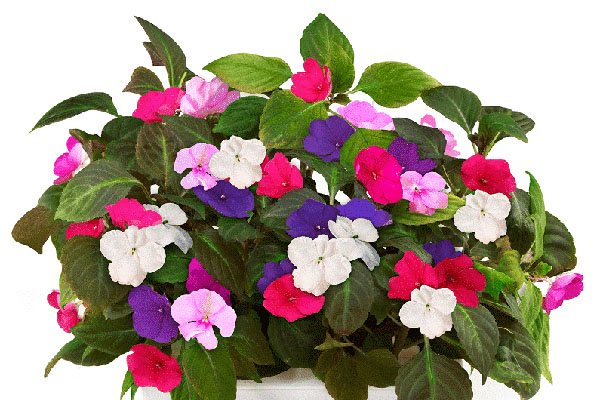

Touch-me-not, ever-flowering, light, Vanka wet flower - all these are the names of one plant, which is often found in our apartments. The homeland of this lovely flower is tropical Asia and Africa. It is one of the most unpretentious and easy to grow at home plants.
The twig takes root easily, grows quickly and looks very impressive during flowering: its compact bushes, strewn with bright flowers, can decorate any room. The flower Vanka wet has another name - balsam. With good care, it can bloom almost all year round, and providing it with favorable conditions is not a big deal.


Even a novice florist can easily cope with the cultivation of this plant. It is perennial, but due to its rapid growth, usually the shoots are elongated, the bush becomes sprawling and soon loses its compact shape. Therefore, balsam lovers often in the spring carry out cuttings of old plants, growing new bushes.
Balsam blooms best when planted in a slightly cramped pot or container. A plant in a pot that is too spacious will not bloom well.
Reproduction of balsam
The flower Vanka is wet in spring and summer. Two methods are suitable for its propagation: by seeds and by cuttings. You can purchase ready-made seeds or get them yourself from your home plant, but for this you need to take care of pollination. Seeds sprout within two weeks.
It takes about the same time to root the cuttings. As you can see in the photo, a wet indoor flower Vanka can easily take root in water. 3-4 pieces of charcoal should be put into the water for rooting cuttings. Side shoots of a plant about 8 cm long are suitable as cuttings.
After the cuttings have taken root, they should be transplanted into small pots. For the first time, the transplanted cuttings should be covered with plastic wrap to ensure a high level of humidity.
This plant does not like sudden temperature changes. However, in winter, it is advisable to lower the temperature for balsam to 14-16 degrees, providing the plant with a dormant period.
Propagation by seeds and cuttings
Reproduction of Vanka wet is carried out by cuttings and the seed method. The second method is more troublesome and is more often practiced by flower growers who like to grow crops from scratch. The seeds can be picked by yourself or bought from the store, but remember that flowers grown in this way will be too weak and will not retain the characteristics of the mother variety.
Given the hassle and unreliability of growing balsam from seeds, most growers practice the cuttings method. Cut twigs take root best in spring and summer, so the planting material should be prepared at this time (Figure 7).


Figure 7. Rooting cuttings - the easiest way to get a young plant
The upper part of the stem, up to 10 cm long, is used as a cutting. All lower leaves should be removed, and the branch itself should be placed in a small container filled with a mixture of wet peat and sand. Next, you need to cover the stalk with a jar to create a greenhouse effect. In the future, it is necessary to monitor the constant moisture content of the soil. If everything was done correctly, after a few weeks the first roots will appear and the plant can begin to be accustomed to fresh air. A month later, the grown seedling is transplanted into a pot.
The features of caring for this unusual culture are discussed in detail in the video.
Garden balsam
Unpretentious balsam - Vanka wet is also used in decorative and home gardening. At the same time, plants of familiar indoor varieties are often used for landscaping areas and landscape design, planting them in containers or open ground.
Along with the houseplant Vanka wet in landscape design, an annual form is also used, which is called "garden balsam". This plant spread from East India, where it is found in the wild. It has a lush erect bush with juicy fleshy shoots and green toothed leaves.
The plant blooms for a long time and abundantly. The flowers of Vanka wet can be simple or double. They are distinguished by a wide palette of various shades. This thermophilic plant requires a well-lit area. Garden balsam is propagated by seeds.
Often, signs and superstitions are associated with a indoor flower Vanka wet. They say that it has a positive effect on creative people, contributes to the creation of an atmosphere of harmony and harmony in the house. If peace and respect reign in the family, this flower will bloom magnificently and lastingly. Misunderstandings and disagreements between family members, on the contrary, can affect the plant negatively.
Vanka wet got its name because of this feature: often droplets of juice appear on its juicy green stems. Probably for the same reason, the superstition arose that because of the flower, family members may become addicted to alcohol.
How these facts are related to each other is not clear. And, of course, it is everyone's business to believe in such signs or ignore them. But in favorable conditions and a sincere home atmosphere, the balsam will bloom and prettier day by day, delighting households with the bright lights of their flowers.
Video about a wonderful plant
It is interesting that back in the 15th century, people thought of keeping plants indoors. True, it was already in Egypt. In China, special rooms were allocated for plants (now they are called greenhouses). In our country, this bright thought came to the minds of the people only in the 19th century.
Roly wet red
Some beliefs and omens are often associated with houseplants. For example, it is believed that there are flowers that cannot be kept at home, but only in the office. There are plants that "love" men and others love women. Many housewives dream of comfort in the house and decorate it with flowers. And if it so happens that women-flowers prevail over men, then the energy is skewed, and such circumstances develop that men begin to leave this house.
It can also happen the other way around. There are vampire flowers that need to be avoided in the house in order to maintain harmony and harmony, as well as the health of the household.
When you visit someone, the plants immediately grab attention. If you see that indoor flowers are beautiful and well-groomed, and also bloom vigorously, then the energy of this house is good, and if the flowers are yellow and lethargic, then we can conclude that something bad is happening in this family.
A plant called Vanka Wet Flower or Ogonyok, as it is also called, is distinguished by its particular beauty and mystery. He came to us from Africa or from America - it is in these countries that the flower lives.
The first time it was presented to the English Queen Elizabeth (16th century), who was amazed when she saw frozen tears of sugar (crystallized juice) on its stems.
The plant got to Russia much later, only in the 19th century. The flower was immediately liked because it is not capricious and beautiful. They called him Vanka-wet. The height of the flower ranges from 40 to 70 cm. Vanka's stems break very easily, so it must be transported very carefully.
Plant diseases
Often, balsam suffers from a spider mite.Trouble happens especially often in dry hot weather. The disease is characterized by the appearance of cobwebs on the leaves, the stems and inflorescences become pale and fall off. How to deal with pests:
- The ground part of a wet indoor plant is sprayed with soapy water.
- To do this, prepare the following solution: dissolve tar, green soap or dishwashing detergent in a sufficient amount of water.
- The foam is left on the plant for 5 minutes.


Then it is washed off with clean water from the shower.- If necessary, the procedure is repeated after 7 days.
- If the soap solution does not have the desired effect, then Ivan is sprayed with an acaricide composition.
- It is purchased at a flower shop.
If the flower grows outdoors, thrips, whitefly and aphids can harm it. Usually pests hide on the underside of foliage.
If the foliage turns yellow, curls or turns gray, then this is an indicator of the presence of pests. To combat parasites, insecticidal solutions are used. For example, a confidor or an actor is often used, they are watered over the soil. Spoiled and diseased leaves are removed.
How to make an orchid bloom at home
Vanka Wet flower of omens
Pink flower
There are several more signs associated with this unusual flower. It turns out that it helps owners to become self-confident and gives masculine strength to the men of the family. It is enough to put a pot with this plant in the bedroom.
The flower does not like a stormy showdown in the family. He kind of absorbs a negative aura and stops helping the owners.
In some regions of Russia, it is believed that this flower in the house brings the husband's alcoholism, but this data has not been confirmed.
Diseases
Sick flower
In winter, balsam is often infected with a fungus. If the soil in the pot is acidic, you urgently need to transplant the light, otherwise it will die. Good drainage is needed in the ground, and it is also necessary to remove all rot from the cuttings.
The scale insect and the spider mite are Vanka's enemies. If the leaves turn yellow and become sticky, then a whitefly attacked the flower. For these purposes, you need to mix water and laundry soap.
Onion infusion will help your flower get rid of aphids. If you smoke next to a flower, it will die.
How to take care at home?
Roly white
Spark or Balsam loves a lot of water. If it is not watered in sufficient quantity, its leaves fall off even at the slightest touch. When the Spark is pollinated, instead of flowers, you can see small berries. Then the berries dry out, and the seeds are inside them.
Balzamin has a lot of obvious advantages. It begins to bloom very early and does it 8 months a year. For 3 years, it can be left without replanting, and it will continue to bloom. Its flowers look like small roses. Balsam can bloom in the yard in special pots and in a flower bed.
However, there are also disadvantages. The plant dies quickly if it is attacked by harmful insects, such as: whitefly, tick. Three times a year, the flower must be treated with a special insect pest repellent. Roly cannot be near other plants, for some reason he drops foliage if this condition is not met.
Balsam loves light, but is afraid of direct sunlight. You need to choose the right place to contain it. It is recommended to choose the soil for the flower wet, sandy and light. The plant should be fed moderately so that the flower does not grow weak - 2 times a year with potassium and phosphorus. Peat is very suitable for Balzamin's life.
Spark lives at a temperature of + 24 degrees and requires spraying in the dry air of the home. During flowering, flower petals should not be touched. Moss or expanded clay can be placed on the bottom of the pot. If the flower has grown, then trim it: the old processes must be removed.
It is immediately visible when the plant lacks lighting.In this case, its leaves become pale, and the cluster of buds decreases.
If your Spark is withered, it is recommended that you move it to a colder place. The flower propagates by cuttings at any time of the year.
Dangerous pests
If harmful insects are bred on the plant, you must immediately begin to fight them.
Spider mite
It spreads to the plant in hot and dry air. The tick settles in internodes, spreads a cobweb on the stems. The foliage of the flower loses color and sags. To get rid of the spider mite, you need to prepare a strong soapy solution in a large container. Laundry soap or other detergent can be used.
Redeem the diseased plant in this solution. The ground part is dipped in foam for five minutes, and then washed with clean water. repeat the procedure after 7 days. To fight the tick, you can use special drugs, for example, Nissoran.
This pest attacks the plant at the beginning of flowering. It can be found on the back of the leaves, which eventually turn silver in color, and the top of the leaves begins to turn yellow. The problem areas of the plant must be removed.
Home flower must be treated with an insecticide or infusion prepared by yourself. For this:
- take 10 g of chopped onions;
- 6 g onion husks;
- fill in with 1 liter of water;
- we insist for 6 hours.
The whole flower is sprayed with the finished infusion.
The second medicinal decoction contains:
- 100 g of chopped hot pepper;
- 1 liter of water;
- the mixture must be boiled for about an hour;
- then let stand for two days, then strain the broth;
- 1 glass of concentrated broth is diluted with clean water - 7 glasses.
The plant is sprayed with this solution.
Why do flowers fall?
Vanka's flowers fall off when he is next to other plants, and this phenomenon may also depend on each of the reasons given above. Any disease or cold, or heat, as well as pests, can cause the petals to fall off the plant.
It must be borne in mind that not all flowers can be kept at home, because not all of them are as useful as Ogonyok. For example, cacti (a girl will not become a happy wife), curly flowers of various kinds (all men will survive from the house) and palm trees (a great grief will happen) do more harm than good if placed in the house.
Watch the video
There are plants in the world that are constantly harmful. Curly flowers, for example, drain energy from a person. Ivy feeds energy vampires. Tradescantia haunts residents in the apartment where it is located. The orchid causes depression and chronic fatigue. The cactus brings aggression into the house. Monstera deprives the owners of the house of energy. Hibiscus leads to chronic fatigue.
Many people do not believe in such things, considering them nonsense. Of course, to believe or not to believe, everyone decides for himself. Only one thing is known for certain that indoor plants adorn our life. If a flower brings you joy and you feel good with it, why not keep it in the house. The main thing, after all, is not a sign, but a reality of life.
After all, not all people, for example, lack energy. There are people who have an excess of this energy, they have nowhere to put it, they torment their loved ones with their excessive activity. This is where vampire flowers will come to your aid. If you put one such flower in the room of an overly active person, then the plant will take from him exactly as much energy as he does not mind giving it away without harm to his own health.
So, you can kill two birds with one stone. And bring a favorite flower in the house and calm the energy of your home activist.
The flame flower as a houseplant has been known for a long time. But, despite its long history, it still enjoys immense popularity. People call it differently: light, Vanka wet, balsam, Zanzibar flower, touch-me-not.
History and description of the flower
The island of Zanzibar, as well as the subtropical regions of Africa and Central Asia, are considered its homeland. Until now, balsam can be found in the wild in the subtropics of India, Africa and North America. The flower was brought to Europe at the end of the 16th century. There he took root superbly. In Russia, Balsamin appeared only in the 19th century. The balsamic family includes about 500 plant species that combine a love of sunlight and moisture. In temperate climates, only 8 species can grow. And 15 were brought into culture.
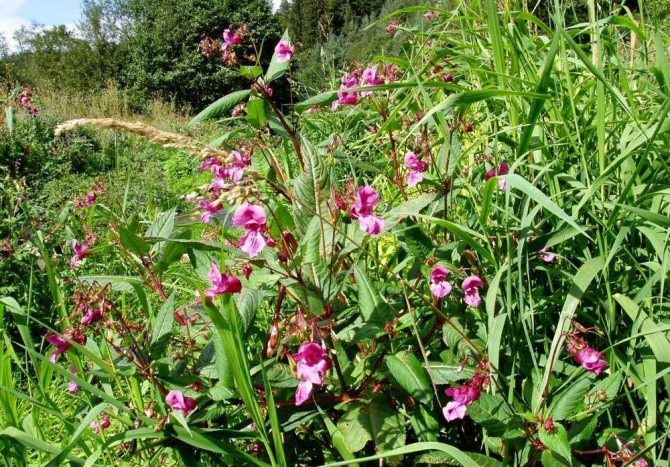

Balsam in the wild
Balsams are annuals and perennials. Annuals usually decorate garden beds with their brightly colored flowers and are very popular. Perennials are grown at home as indoor flowers that bloom almost all year round.
Balsam's stems are transparent, juicy and brittle. Their length is 35-50 cm and more. Growth form - erect, bush or ampelous. The root system is lobular. Leaves are elongated-oval (about 7 cm long) or heart-shaped, widening at the petiole and tapering towards the tip. The arrangement of the leaves is alternate. On the edge of the leaves there are small or large denticles, ending in a small thorn. The color of the leaves is usually light green or rich green, but there are species with dark green leaves with a lilac or brown tint. The veins are clearly visible on the leaves slightly darker than the main tone.
Balsam's flowers have 5 petals of an unusual shape. They are freely located, intergrown in pairs, solitary or collected in inflorescences. In the inflorescence, one petal elongated into a spur sometimes comes across. The color of the petals has all sorts of shades of pink, red, white and purple. The small white bud opens with large, bright and richly colored petals.
There are balsams with bicolor flowers, with different shapes of buds, for example, in the form of a rose, fringed, carnation or camellia. There are flowers with double and semi-double petals. Faded buds form green fruits. When ripe, these fruits form a dry capsule.
General information
The houseplant light belongs to the genus balsamic, which has about half a thousand of both annual and perennial herbaceous plants. Its homeland is considered to be the tropics and subtropics of Africa and Asia, although some species can be found in Central Asia.
In 1596, the first flowers of the wisp appeared in Europe. This plant is quite unpretentious, blooms all year round and also multiplies easily. Thanks to all of the above advantages, balsam has been loved all over the world for more than four hundred years.
Description
Wisp flowers have juicy and highly branched stems. Their height, depending on the variety, varies from 15 to 50 cm.The color of their leaves largely depends on the species. They can be green, bronze and reddish. The leaves are rather fleshy, and wavy around the edges. At high air humidity droplets of liquid form on them. It is for this feature that he was called among the people Vanka wet.
The balsam flowers grow from the axils of the leaves, they are small and very bright, which evokes associations with multi-colored bulbs. This is where the name "light" came from.
At the end of flowering, the plant has fruits, and after ripening, they turn into a dry box filled with seeds. Even with the slightest touch to it, it explodes, as it were, scattering the contents in all directions. It is this feature of balsam that gave it the following name - "touchy".
The most popular species and varieties
Waller
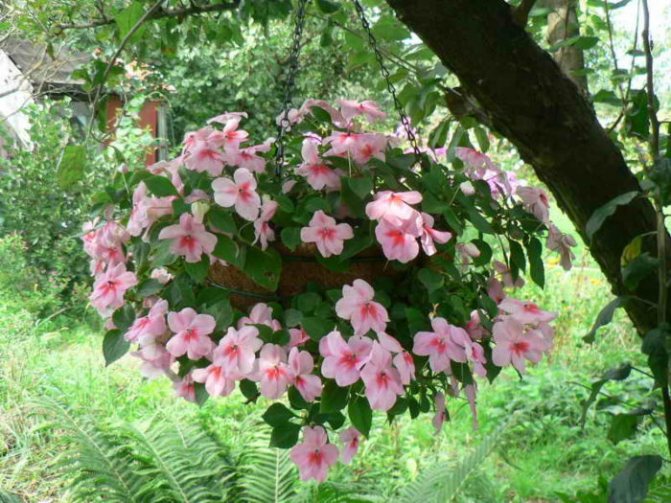

It is a bush up to 50 cm high. It has erect, succulent stems, tender wide green or brownish oval leaves.This Balsam loves warmth and light, and this circumstance must be taken into account when choosing his place of residence. Flowers can be one-color or two-color, abundant flowering. Waller's balsam became the progenitor of numerous hybrid varieties.
New guinea
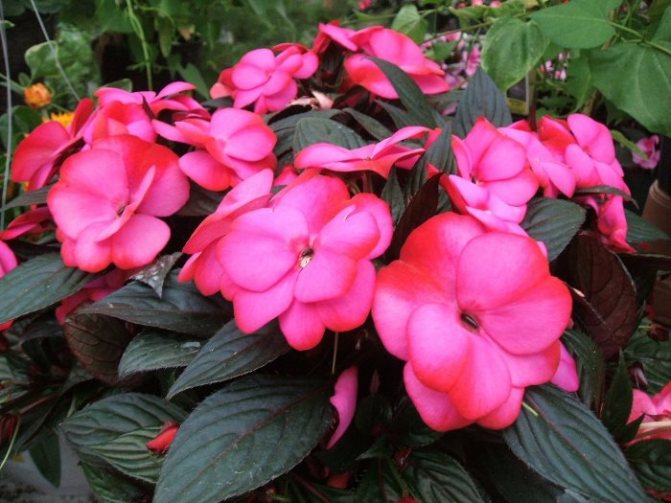

Balsam New Guinea is a hybrid perennial plant with large flowers of bright colors. Can be grown both outdoors and in a pot on a windowsill. Not afraid of direct sunlight. Differs in resistance to pests and diseases. The beautiful leaves have a rich green color with yellow veins. Blooms profusely in a warm, sunny place.
It may be interesting: Complete classification of species and varieties of Violets (Saintpaulia)
Kandy
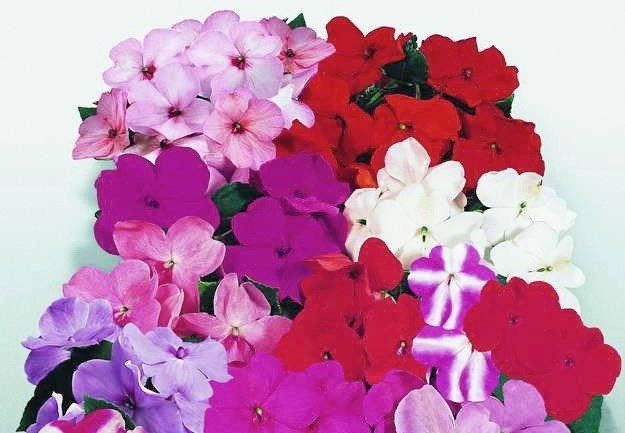

This is a young, recently bred variety. The bush has smooth, juicy stems up to half a meter long, from which petioles with oblong leaves with a pointed tip extend. The color of the leaves has various shades of green. Abundant flowering, buds on high pedicels have different colors. The flowers are soft and velvety to the touch. The variety is decorative and not picky about care.
Strawberry with cream


This is a spectacular terry variety of Balsamin with red-white flowers up to 4 cm in diameter. A compact plant with well-branched stems. Blooms for a long time even with light shading.
Peters
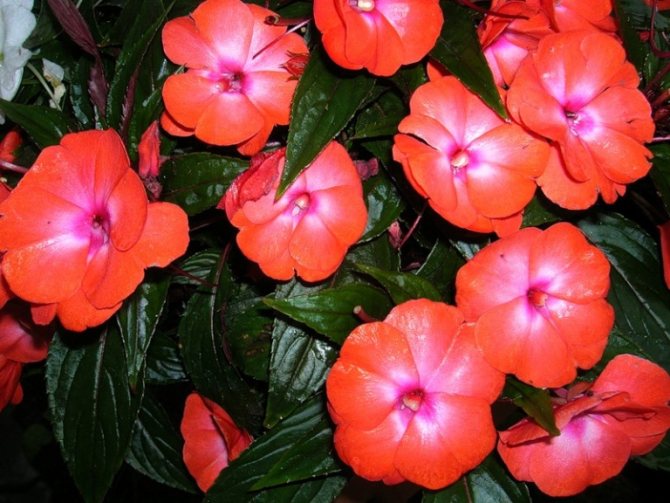

This species is distinguished by the color of the foliage - it has a bronze tint. It blooms profusely with bright red flowers.
Orchidaceous


This species has a juicy brittle stem of dark pink color. Velvety to the touch, dark green leaves have dark pink or red veins that run along the entire length of the leaves. The flowers are shoe-shaped. The petals are painted white, sometimes with yellow-orange or burgundy blotches. This balsam is not affected by spider mites.
Tom Thumb


A beautiful and profusely flowering bush of compact size with branched stems and bright, double large flowers. It can be grown as an indoor flower or outdoors. This variety loves sunny places, but is able to grow and bloom in partial shade and even in the shade, where its branches and flowers will be smaller. The flower should be watered abundantly, as it does not tolerate drying out of the soil. To make the bush more branched, its tops need to be pinched. Indoor Balsam can grow in a cramped pot. In the open field, the size of the flower will undoubtedly be large.
Cutie


It is a beautiful compact bush with dense foliage. It blooms wonderfully with pink or white flowers at home - all year round, and in the garden - all summer. Its height does not exceed 20 cm. Loves warmth. It grows both in the sun and in light partial shade.
Salmon Chiffon
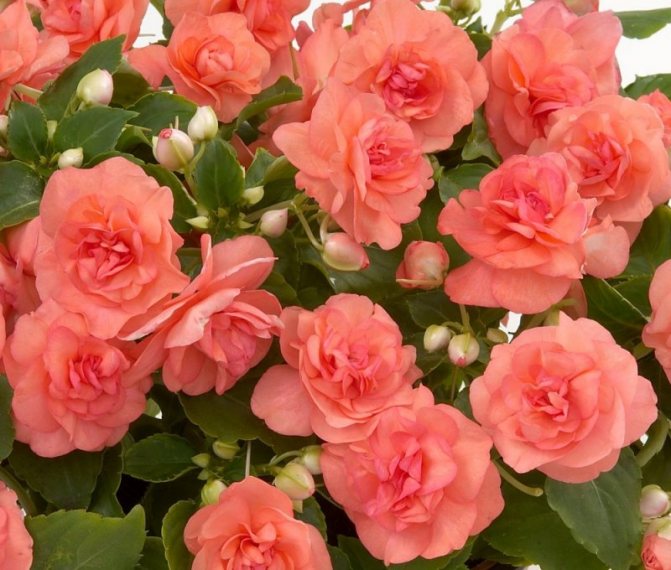

This bush is notable for its long and abundant flowering of incredibly large double flowers of bright color. The petals are reminiscent of the delicate fabric of chiffon in a bright salmon shade.
There are still a huge number of other varieties, but they are more capricious, require more painstaking care, therefore they are less common in the collections of novice florists. In this article, we will introduce you to the rules for caring for Balsams, which will be within the reach of the laziest or busiest grower.
Selection
Home flower balsam, the care of which does not present any special problems, can be red, pink, white, purple, orange, as well as speckled and striped. Thanks to the many years of efforts of breeders, hybrids with multicolored leaves and unusual double flowers were bred. In addition, there are special varieties for outdoor flower gardens that can successfully withstand low temperatures. These hybrid plants can delight the eye until frost, decorating flower beds and balconies. But still, by and large, the light is an indoor flower, so it is perfect both for landscaping educational institutions and kindergartens, and for a children's room.
Conditions of maintenance and care
The balsam flower is unpretentious, so it will not bring much trouble to its owners. By the way the plant begins to shed the lower leaves, one can judge about improper care of it. Another reason is aging. In this case, the plant must be rejuvenated.
Although balsam is unpretentious and will grow not only on the window, but even somewhere in the corner, it still needs bright light for several hours a day for abundant and long-lasting flowering. The most comfortable for this plant will be the west or east window. On the southern side, and even at the height of summer, you cannot put a flower, but since it happened so, you will have to shade it from the destructive rays. In the warm season, this plant feels great on the balcony.
There are no special requirements for the soil. Wisp flowers can grow in almost any loose nutrient mixture. As for the temperature, it should be normal room temperature, but not lower than 12-15⁰ C.
Care rules
This is an unpretentious plant to care for. The main thing is not to forget about watering. The soil in the container where the balsam grows must always be moist. Its name reminds of it - wet. Taking care of Ivan is quite simple, he loves spraying. If the balsam lacks moisture, then its leaves wither, turn yellow and may fall off. If the flower is not watered for more than 3 days, then its leaves dry at the ends. If you do not resume the flow of moisture into the soil, the plant will die. In the summer, balsam needs daily watering. In winter, moisture is reduced. What should be the temperature in the room:
- In winter, at least 14 degrees Celsius.
- If the hostess wants the plant to bloom, then the temperature in the room should be at least 17 degrees.
- Balsam is native to the tropics, so it loves warmth.
Dendrobium orchid care at home
The plant is drawn to the light. But it should not be placed in direct sunlight. In summer, if the window faces south, it is better to protect the plant. To do this, it must be removed deep into the room, into the shade. In order for the balsam to continue to delight the grower with beautiful flowers, he must spend at least several hours a day in direct sunlight. Ivan loves to be sprayed frequently. This procedure avoids the ingress of water on the inflorescences. Transfer:
- The plant loves when its roots fill the container with soil.
- The soil for balsam should consist of turf, peat, humus and sand.
- These ingredients are taken in equal amounts depending on the size of the pot.
- Drainage is placed at the bottom.
- Experts recommend replanting balsam once a year.
- It is better to do this in the spring, in March.
- It is not necessary to take too large a container for transplanting, because Ivan does not like large pots.
- For the well-being of balsam, it is enough to replace the soil.
Fertilization and watering
In order for the fire to have beautiful and bright flowers, it is necessary to feed the plant from spring to autumn by fertilizing the soil in a pot every two weeks. In this case, the main thing is not to overdo it. The fact is that an excess of nitrogen fertilizers has a good effect on the growth of stems, but slows down the formation of flowers.
These plants are very fond of moisture, which is why they have such juicy stems. The flowers will not die from poor watering. They will simply lose their former elasticity and begin to shed the lower leaves. In the warm season, the plants need to be moistened quite often, and in the winter, watering should be somewhat reduced, while in no case should the soil in the pot dry out. At the same time, stagnant water accumulating in the sump is very harmful, as it can provoke rotting not only of the stems, but also of the roots.
Signs and superstitions
There are several popular beliefs and signs associated with Vanka wet, mostly positive. For example:
- In order for the family to be okay, it is necessary to monitor the state of the flower, while it is good, and the family is good, as soon as the balsam is sick, it is necessary to wait for quarrels and discord.
- To stop the quarrels, you need to buy balsam for the house. The same works for offices.
- Wet Roly attracts inspiration. It is useful for creative people to keep it close to them.
- It has a good effect on men, helps them to acquire masculinity, attracts good luck, strength, courage and physical health.


However, there are also a couple of bad omens. The appearance of this flower was once associated with the fact that a man in the family began to drink hard.
And if the balsam is withering away, then something is wrong in the house. It was believed that this flower is very sensitive to scandals, squabbles and an unhealthy atmosphere in the family.
Vanka must be wet on every windowsill, and not only because it brings good luck and removes negativity, but also because it pleases the eye and softens the heart.
Reproduction
It happens very easily with balsams. These plants can propagate in two ways: either by seed or by cuttings. These bright flowers have relatively large seeds that are sown at the very end of winter and early spring in greenhouses or greenhouses. They germinate well at 23 to 25⁰ C for three to four weeks.
In spring and summer, the stems of balsam, which have reached a length of about 8-12 cm, are cut off, and then rooted in water or immediately in moist soil, to which sand is previously added. Cuttings eject roots in just a few days, after which they are ready to be planted in small pots. Somewhere in 2-3 months, the adopted young plants can already please their mistress with beautiful and bright flowers.
Pests and diseases
Balsams often suffer from aphids and whiteflies. Sometimes, if the air in the room is too dry, spider mites can attack the plants. In order to get rid of harmful insects, it is necessary to spray the flower with insecticides. Excess moisture is also undesirable, as it leads to the appearance of gray rot.
It so happens that the balsam flower loses its lower leaves all the time. This suggests that the conditions in which he finds himself are categorically unsuitable for him. Loss of leaves can occur for three reasons: pest damage, hypothermia, or irregular watering. The reason for the fall of flowers can be both drying out of the soil and poorly humidified air.
As you know, balsam belongs to abundant flowering plants. But sometimes, with a lack of nutrients, light or heat, it practically stops blooming. Also, the reason for this may be transplanting it into an oversized pot.
Sometimes the leaves on the plant suddenly begin to wither. The first reason for this may be a lack of moisture. If, after watering, the leaves have not acquired their former elasticity, this means that the root system of the plant has rotted as a result of pest damage or excessive watering.
Pests do not bypass him either.
Balsam can be affected by aphids and whiteflies. But the spider mite is especially dangerous for the plant. If pests are found, you need to immediately treat the balsam with insecticides. Severe waterlogging of the substrate often leads to infection with sciarids. If these pests are found in the soil, the plant must be removed from the pot, rinsed the roots, transplanted into healthy soil and reduced watering.

